You would think plantains would be prolific here in Congo, where banana trees propagate by the side of practically every path. But somehow this paladin of Pan-African cooking perennially passes us by in the pandemonium of the public market here.
I have no idea why the plantain supply is so paltry, nor why I’m so partial to P’s. It’s been raining for three days straight now; I must be feeling a little pallid.
(Sorry. I’ll arrêt with the alliteration now.)
On the rare occasions I do spot plantains for sale, I snap them up. Ripe or unripe, doesn’t matter to me, I have uses for both. I’ve been collecting African cookbooks for awhile now and plantains are a key ingredient in many recipes.
Chances are good that if you’ve ever eaten plantains before, they were probably served dessert-style. Unlike bananas, plantains are always cooked, even if they are well and truly ripe. Once ripened and cooked (usually fried in butter and maybe a little brown sugar), they become sweet and decadent.
Most of the time around here, and from what I’ve seen back home, there’s an obvious difference between plantains and bananas. Plantains are much larger than bananas, have a pointy tip, have a much thicker peel that can be difficult to remove, and are way starchier.
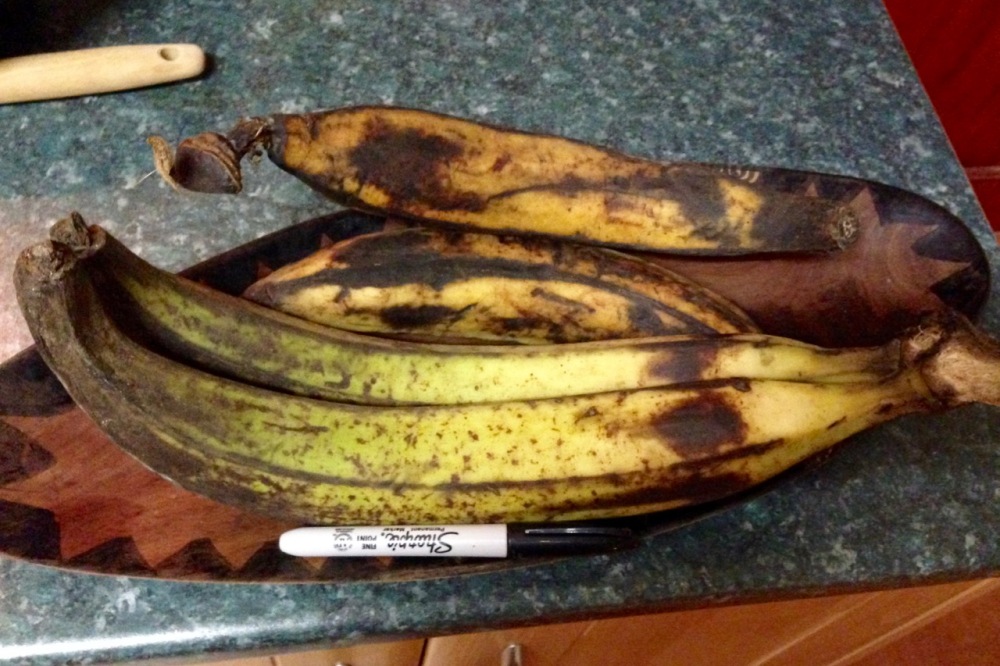
Two kinds of plantains here, plus a Sharpie for scale: larger greener ones, and smaller riper ones. The smaller ones made the fried plantains pictured above four days later, when their skins were practically all black.
So I was surprised to learn that botanically speaking, there’s no difference between plantains and bananas. In some countries where both are prolific, they don’t even use different words for them. Some sources say the difference is purely cultural: if you cook them they’re called plantains; if you eat them raw they’re bananas.
Then there’s my little iPhone app called “Specialty Produce” that says: “Plantains are considered a superfood. They have more than twenty times the amount of vitamin A, about three times the vitamin C, double the magnesium, and almost twice the potassium as the common banana.”
Sounds to me like they’re quite different. They definitely cook up differently too, especially as they ripen, as I found after making plenty of mistakes in the kitchen. I was about to get a whole lot of practice, though, which would include blurring the line between green plantains and green bananas.
One day last October, Seb came across a lucky find. He spotted a man pushing a bicycle along the national road right here in town, loaded down with bananas. Among them was one bunch that looked different than the rest. It was greener, pointier, a smaller variety than the huge arm-length plantains we usually buy, but still, definitely not your normal banana. He stopped and asked the man if those weren’t plantains. A couple bucks later he was surprised to find out he had purchased the whole “regime.”
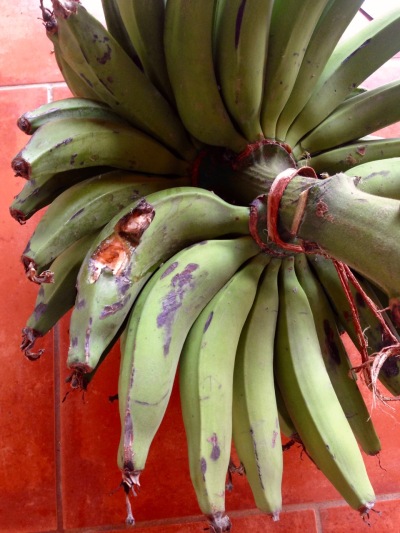
An entire bunch of small unripe “plantains” sitting on our porch, minus a mysterious monkey-shaped bite. Lucy was very curious about these at first, but must have decided they were too green for her.
I shared the loot with my Puerto Rican neighbor who also loves plantains, and in return she gave me more recipe ideas to add to my stack. After cooking them, she came to the conclusion pretty quickly that these were not actually plantains, but I forged ahead anyway. Let’s call them something in between a banana and a plantain. It worked for me, and as they ripened and darkened over the next several weeks, at no point did they look like something I would want to peel and eat raw.
The next several days were spent in search of more ingredients, and then I got busy cooking. No need to wait for them to ripen — the green, unripe version is much more interesting, anyway. They’re more like a vegetable in this state, kind of like potatoes, and there’s a lot more you can do with them.
First up, one of the national dishes of Puerto Rico: Escabeche de Guineos y Mollejas. Pickled green bananas and chicken gizzards. Mmm, sounds lovely, doesn’t it?
My neighbor said even she usually skips the gizzards. But our local grocery store has so very little in the frozen meat department that looks palatable, I couldn’t bypass the one thing that wasn’t freezer burned. That’s right: Our local grocery store sells decent-looking frozen chicken gizzards by the bagload. And except for my dad frying up the occasional chicken heart from the little bag of giblets that came with our chickens when I was kid, I had no idea if I even liked gizzards. So I took it as a sign that I must give them a try.

Mmm, raw onions and boiled chicken gizzards! Boiled green plantains, green olives and a garlic vinaigrette will be added next, before baking all together.
Let me tell you, I’m quite glad that I did. Seb and Viviane and I all enjoyed this dish several days in a row. (It made a big batch, and kept well.) Viviane even asked me for the recipe, which I gave her along with the remaining half-bag of gizzards. She went home, procured some green bananas from a neighbor, and cooked up this recipe for her husband and some friends, impressing them all to bits. She said nobody knew that green bananas could be cooked and eaten like that. She was quite proud of herself.
Although the names are similar, I found an entirely different-looking recipe online: Guineos en Escabeche, aka Pickled Green Bananas. This one is more of a condiment, whereas the first was a main dish. Here, the pickling liquid smelled like heaven, and looked quite beautiful, too.
I questioned the ratio of oil to vinegar to bananas here – 2½ cups oil to ¾ cup vinegar to 12 oz bananas – and doublechecked the website. There were no comments or corrections about it, so I went with it. After chilling overnight, I found that it was, unfortunately, as inedible as it sounded. WAY too oily. When I showed the recipe to my neighbor, she said it should have been more like 2 cups oil to 1 cup vinegar to 24 oz bananas. I could have tried to fix what was sitting in my fridge, but had already moved on to other recipes. Next time I get a batch of green bananas or plantains or whatever, I will definitely try this again.
I had to keep moving on for an important dinner guest. Seb’s most senior guy, Congolese mentor, and someone we consider a national treasure, Papa Nzita, was coming over for dinner. The last time Papa Nzita came over for dinner, he didn’t even touch the main dish — beautiful French quails I had been saving for a special occasion, nicely browned in a lovely peanut-pepper-cocoa sauce. He said he simply doesn’t eat small birds, and “il faut pas forcer” (don’t force me). Luckily I had prepared lots of side dishes.
After gathering a list of Papa Nzita’s likes and dislikes and comparing it to what we had on hand, I was left with the most logical choice: defrost some frozen whole tilapia, figure out how to fillet them (despite having never filleted a fish before), harvest a banana leaf from a neighbor’s tree, and put those green plantains to good use. Papa Nzita said he loved plantains, but when I asked if he’d ever eaten them green, he scrunched up his nose. I was nervous.

tilapia in a chile-ginger-garlic-cilantro spice rub… (there’s more fish hiding under the lemon, hey I’m not an expert filleter nor food stylist)
After the fish was cooked, I stirred a bunch of lenga-lenga, the local amaranth greens I wrote about awhile back, into the rice. Served with homemade mango chutney using mangoes harvested from our own tree, and pineapple-oatmeal squares with fresh pineapple from the local market. How’s that for farm-to-table eating!
This time there was no need to worry; Papa Nzita loved it, and so did we. This fabulous recipe, which I shall rename “Everything Papa Nzita Likes in One Pot,” came from Marcus Samuelsson’s excellent African cookbook, “The Soul of a New Cuisine.” He credits West Africa as the inspiration here, and to make it more approachable for cooks back home, calls for snapper and spinach instead of tilapia and lenga-lenga.
Next up, another one of my favorite outcomes of this whole experiment, also from Marcus. This is his updated take on a Ugandan classic called “motoke,” which we enjoyed while visiting Uganda. Except here, instead of being wrapped in banana leaves and buried in smoldering ashes, the plantains are roasted in the oven with maple syrup, soy sauce, and warm spices, then placed on top of roasted eggplant purée sprinkled with green onions.
Two more tasty experiments from Marcus followed on the heels of the others:
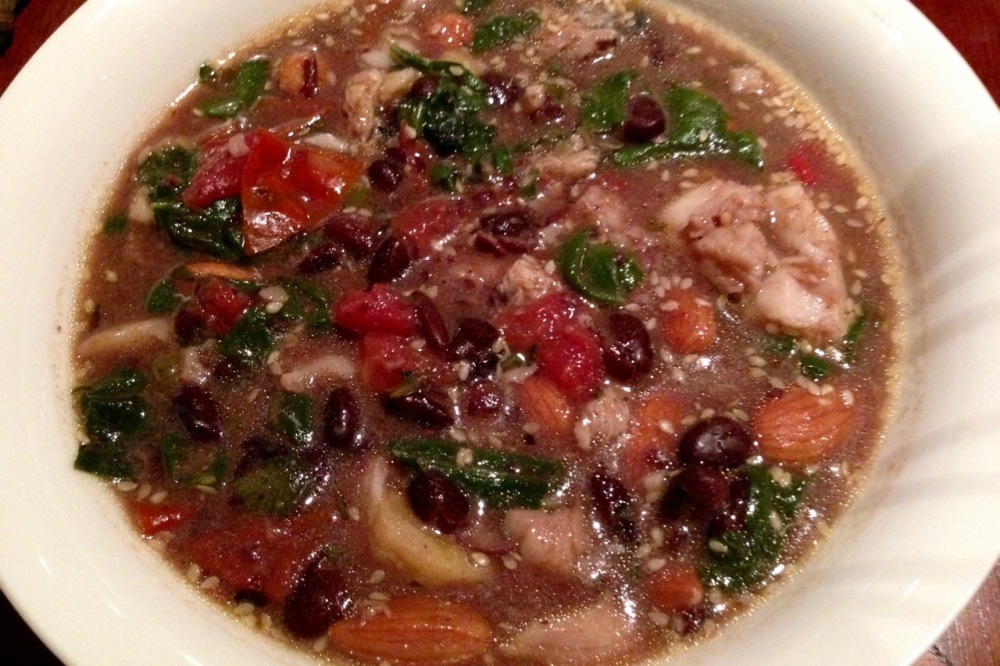
Cod Stew with black beans, jalapeños, plantains, tomatoes, spinach, almonds and sesame seeds — from Libya (better than it sounds, or looks)
As the plantains sitting on my living room floor (safe from curious monkeys) started ripening, I happened to get my hands on a couple of ripe mangoes, fresh chilies, fresh cilantro, and ripe avocado at the same time. This never happens!! AND I had recently returned from Florida where I’d been able to stock up on dehydrated black beans and fresh limes (yes, I gladly carry real limes home in my luggage). So all the stars aligned and after a couple years of waiting I got to make this incredibly yummy, very tropical dish from one of my favorite vegetarian websites, Herbivoracious.
There have been plenty of other plantain successes and failures, though I didn’t document them as I went. One of my all-time favorites is a recipe from Reza Mahammad, the self-proclaimed “Spice Prince of India.” It’s your basic fried plantains but the spicy coconut-yogurt sauce is to die for. Here, I’ll show you HIS photo since I don’t have my own… but for the recipe, you’ll have to buy his book!
Trust me, Reza’s book is worth a buy. So is Marcus’ book. The first recipe of his I ever tried, Plantain-Coconut Stew, remains another plantain favorite. I’ve also made his Candied Yams & Plantains, and Plantain-Crusted Yellowtail. Believe it or not, there remains a lot more I’d like to try, and a lot more I’d like to try again. Plantains (or green bananas or whatever the heck they are) are super tasty, filling, and apparently quite good for you. They are served at every meal in some cultures, notably Uganda, where they’re even made into beer. Hey, now there’s an idea… Here’s hoping Seb finds another Big Batch of Bananas for me very soon!

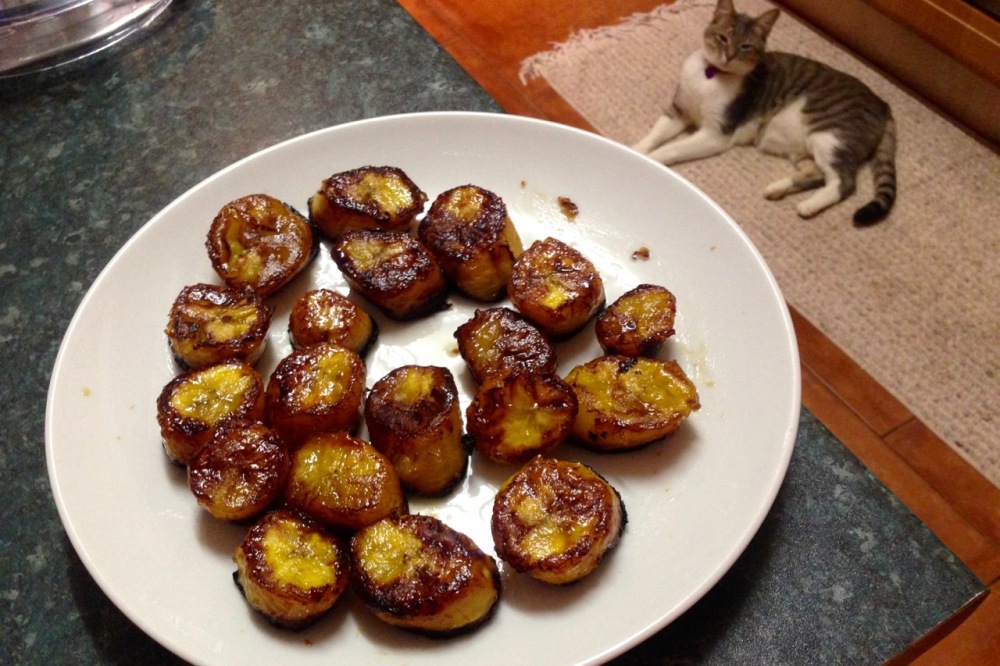
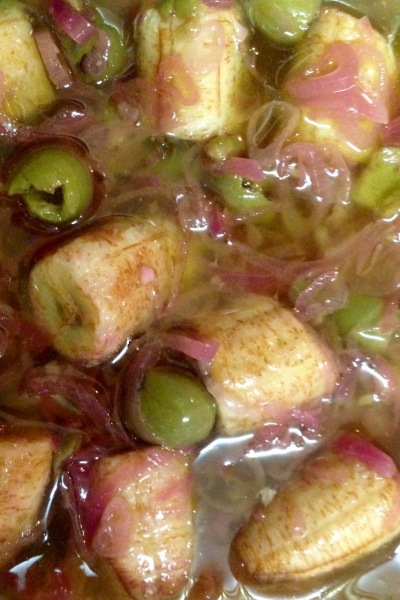



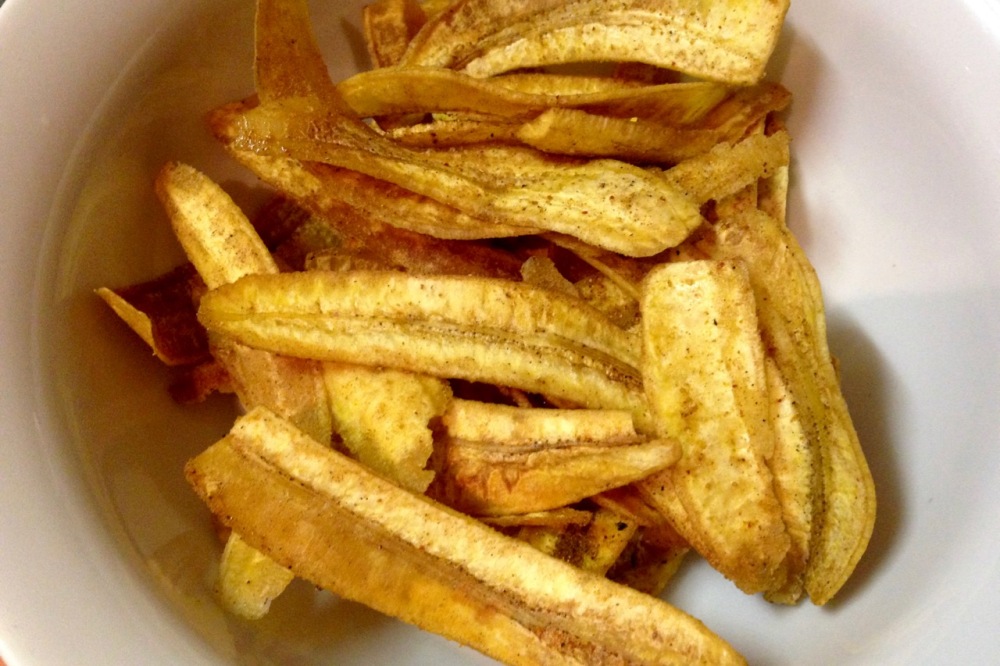

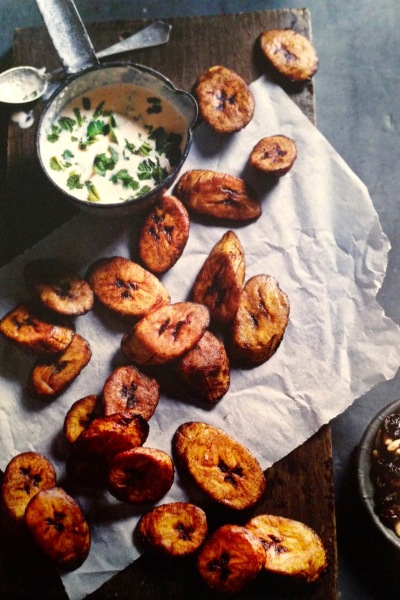
Here’s the recipe for the sweet, fried, Plátanos Maduros (with a photo way prettier than mine):
http://www.slate.com/blogs/browbeat/2014/03/06/plantains_recipe_how_to_make_sweet_restaurant_style_platanos_maduros_at.html
Another good recipe I didn’t mention: http://www.foodandwine.com/recipes/west-african-chicken-soup
There are four other recipes hyperlinked within the text. A note on the Escabeche de Guineos y Mollejas (Pickled Green Bananas & Gizzards): My Puerto Rican friend says that normally the onions are sautéed, not raw like mine. Everything is cooked separately, then combined — no “baking” it all together in the oven. Also that green olives are more common than black. (Indeed, the raw onions never really cooked in the oven, and the green olives were a nice touch. Also found the French-style dressing indispensable.)
LikeLike
I’m very impressed Jen! All the dishes sound and look delicious. Plantains are eaten a lot in Venrzuela so I may have to dable with some of these recipes.
LikeLike
Yes! Please do! Let me know how else you recommend them. (I’ve also tried and loved tostones)
LikeLike
I have never tried plantains of any type–but you are making me want to try them!
LikeLike
Let’s go to the Cuban restaurant in Wichita next time and try them 😉
LikeLike
Deep fried chicken gizzards is one of my favorites! Luckily, one of our grocery stores has them regularly.
LikeLike
Deep-fried, interesting! These were just boiled. Minus lots of gray foam scraped off the top, and several rinses.
LikeLike
Plantains looks perfect for the marathoner’s diet … especially before, during and after a 26.2 miler! I’ll forward your Plantain Panoply to son Todd who is our culinary guru!
LikeLike
I’m no marathon runner but I’m sure you’re right! You probably had dishes like this all the time in Hawaii, yes? I hear there’s an avocado shortage in Australia, people are quite upset. We’re lucky to have these delicious foods at our fingertips!
LikeLike
It all looks and sounds good, except for the chicken gizzards. 🙂
LikeLike
They were not bad!
LikeLike